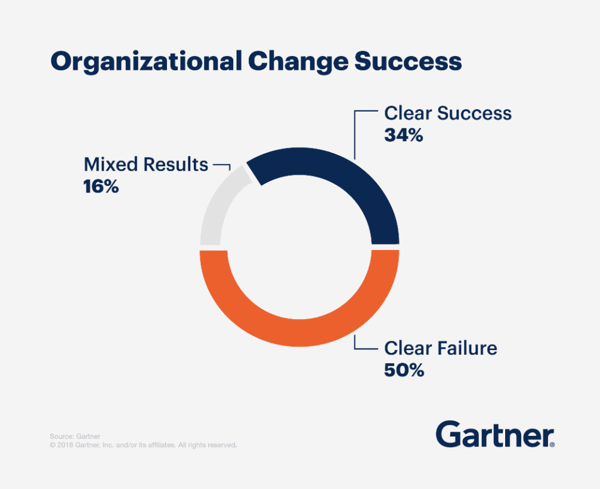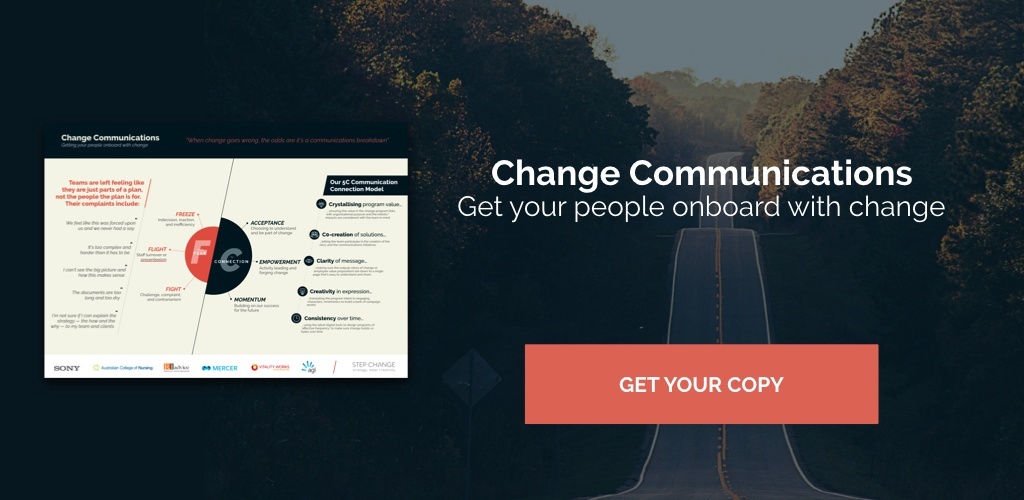In disruptive times, change may be essentially imposed to improve what is not working or steer the wheel towards a new direction.
No matter what type of change your organisation is going through, having the means to measure success and being able to report the progress to the board are crucial to ensuring that your organisation stays afloat as it wades through these challenging times.
Insight: Successful organisational transformations require leadership alignment and effective change management that fully supports the vision for change.
Data: McKinsey reports that 70% of all transformations fail to achieve their goals. More often than not, this is brought about by bad management, lack of support, and negative employee behaviour.
Key Action Point: Use these key points to augment your existing efforts and map out a more effective change management program that gets the full support of the board and every member of your organisation.
In all your change management efforts, having the means to validate the progress and success of your change initiatives is crucial.
In this sense, reporting to the board regularly about your transformational initiatives and activities allows you to stay more visible and helps the board to put more value into what you have done.
Here are key reasons why reporting on transformational activities is crucial to success.
Increases Communication of Activity
Reporting on your change initiatives helps increase awareness and acceptance of progress. Many organisations are now turning to digital change management solutions to effectively plan, manage, and report on changes happening across the entire business.
Change management software tools that you can use include:
- Gensuite. This change management software is useful for helping teams discover and manage risks and compliance requirements as operational, equipment, and people-related changes happen.
- Intelligent Service Management. This is another change management solution that allows an organisation to plan rollouts and execute changes. It makes use of industry best practices that help drive speed and accuracy in implementing changes.
- Remedy Change Management 9. This change management platform was created by BMC Software. Geared more towards IT companies, this software helps IT companies identify potential risks when dealing with changes within the organisation.
Adds Value and Validates Your Change Management Efforts
By reporting on the changes happening within your organisation, you have the ability to highlight the positive impact of your initiatives or focus on any challenges that you may be facing to the board.
It also brings to the table all the change initiatives and projects being done, how the change management team is dealing with each one, and what efforts are worth focusing your resources on.
Communicates Risk
A report from Deloitte points out that 1.6% of board directors said their CFO spends between 50% and 75% of their time on risk issues, compared with 5.4% of CFOs who said they devote that proportion of their time to risk issues. This means regularly communicating risks and mitigations is crucial to keeping the board involved.
Measures Success
Change management reporting helps you measure the success of your efforts and allows you to align your goals with that of the board and the entire organisation.
Managing Reputational Risk during Transformation
To a discerning audience, your reputation is the public’s perception of your trustworthiness and integrity. One might say your reputation is your biggest asset.
In business, a damaged reputation can be difficult to repair, which is why it is absolutely critical to protect it with everything you have.

Reputation risk acknowledges all the threats to your business value and earnings as a result of a bad image or a negative perception from your most important stakeholders.
It can lead to a loss in brand value or your organisation’s ability to influence or make an impact.
To manage reputational risk, you need to start at the top and align your strategy from the board down to your employees.
Getting Teams Onboard through Internal Communications

One of the biggest challenges in transformational activities within organisations is getting your teams onboard with the change.
Most often, the culprit is a communication breakdown. This can lead to teams feeling just parts of a plan instead of seeing themselves as the reason for the plan.
They may also feel that they have no control over what is happening and that the change was only forced upon them.
Failed internal communication during times of organisational change leads to unnecessary fear which may turn into employee resistance.
Our 5C Communication Connection model focuses on promoting acceptance, empowerment, and momentum during times of change. It emphasises these five key points:
- Crystallising program value. Ensure the value in the change program links with organisational purpose and impacts are considered with the team in mind.
- Co-creation of solutions. Let the team participate in the creation of the story and the communications initiatives.
- Clarity of message. Ensure the outputs(story of change or employee value proposition are down to a single page that’s easy to understand and share.
- Creativity in expression. Translate the program intent to engaging characters.
- Consistency over time. Use the latest digital tools to design programs of effective frequency to make sure change builds vs fades over time.
Mapping the Process for Transformation
Many organisations often have to contend with more than one change program. And it is not common for organisations to struggle to implement but one.
Failing on this front can be attributed to the inability to sustain such projects, lack of focus and support, or inefficient processes that make it difficult to implement these programs.

Image credit: Gartner
To prevent this from happening and be more successful in your organisational change efforts, it is important to create a mapping process for your change program or transformation activities.
Some stages that should be considered during the mapping process are the following:
- Understanding the business’s current processes. Do you and your teams fully understand how your business works? Is everyone aligned on your organisational goals?
- Identifying a need or opportunities for growth. What does your business currently need to win and achieve your long-term goals and objectives?
- Identifying a solution or change initiative. What can you do differently, and what process improvement can foster growth?
- Solution planning and scheduling. Set realistic timelines on your change program’s critical stages. Who will lead the change?
- Process documentation. Document your transformational activities and keep track of important events and projects to help your team spot and correct process bottlenecks in the program.
- Identifying key change program benefits and requirements. Tracking the change program’s key benefits helps you stay aligned on goals and helps you stay on top of any business or process requirements needed.
- Data gathering and collection. Gather inputs and outputs from internal and external stakeholders.
- Process map transcription. Creating and designing change diagrams and workflows will help you visualise your organisation’s transformational activities and which teams and departments are involved in key stages.
- Process review and update. Change is an ongoing process. Review what has been accomplished and what remains in the pipeline and keep stakeholders up to speed with the wins as well as areas that need further support.
By mapping out a clear process for your transformation program, you have a clearer understanding of what it is your organisation needs to do and what you want to accomplish.
Not only will this support the organisation in developing the new system, but it also ensures everything is more seamless during periods of testing and training and throughout your internal communication, which makes it easier to gather support for all your current change programs.
Drive Transformation Forward
The road to transformation can be a long and arduous process. And throughout this time, change management reporting can fall on the wayside, and you may start to lose sight of your core goals and why you’ve initiated the change in the first place.
Reporting your transformation initiatives effectively to the board helps you stay on track, promotes visibility, communicates critical risks, monitors performance, and measures success.
By making use of change management software available today, improving communication, and creating a clear mapping process, you are in a far better position to help your organisation own the change, which leads to better implementation and a much higher chance of driving your transformation efforts to the finish line.













![Top 10 Articles C-Suites Read in the Step Change Blog [2019 Edition]](https://blog.hellostepchange.com/hubfs/step-change-top-10-articles-2019.001.jpeg)



